INDIAN ARMED FORCES CHIEFS ON OUR RELENTLESS AND FOCUSED PUBLISHING EFFORTS

The insightful articles, inspiring narrations and analytical perspectives presented by the Editorial Team, establish an alluring connect with the reader. My compliments and best wishes to SP Guide Publications.

"Over the past 60 years, the growth of SP Guide Publications has mirrored the rising stature of Indian Navy. Its well-researched and informative magazines on Defence and Aerospace sector have served to shape an educated opinion of our military personnel, policy makers and the public alike. I wish SP's Publication team continued success, fair winds and following seas in all future endeavour!"

Since, its inception in 1964, SP Guide Publications has consistently demonstrated commitment to high-quality journalism in the aerospace and defence sectors, earning a well-deserved reputation as Asia's largest media house in this domain. I wish SP Guide Publications continued success in its pursuit of excellence.
- Operation Sindoor: Resolute yet Restrained
- India’s Operation Sindoor Sends a Clear Message to Terror and the World – ‘ZERO TOLERANCE’
- Japan and India set forth a defence cooperation consultancy framework, talks on tank and jet engines
- Terrorist Attack in Pahalgam in Kashmir: Unfolding a long surgical war against PAK
- Lt General Pratik Sharma takes over Command of Indian Army's Northern Command
Chandrayan-3 and Quantum Technology Satellite
Exploring the final frontier together, Indian and US to collaborate on New Horizons in Space
 |
The Author is Former Director General of Information Systems and A Special Forces Veteran, Indian Army |
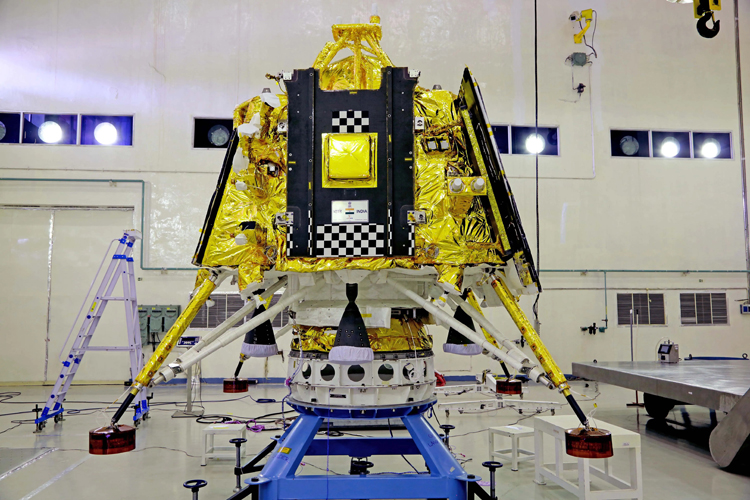
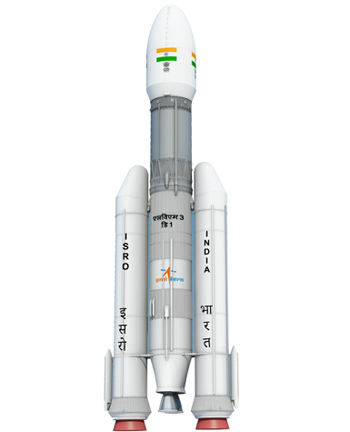
During the four-day state visit of Prime Minister Narendra Modi to the US in June 2023, the joint India-US statement issued by While House on June 22, 2023, said that Indian Prime Minister Narendra Modi and US President Joe Biden welcomed the decision of NASA and ISRO to develop a strategic framework for human spaceflight cooperation by the end of 2023. NASA is to provide advanced training to Indian astronauts at the Johnson Space Center in Houston, Texas, with a goal of mounting a joint effort to the International Space Station in 2024. Both leaders called for enhanced commercial collaboration between the US and Indian private sectors and to address export controls and facilitate technology transfer.
ISRO’s Chandrayan-3 mission is scheduled to launch on July 13, 2023 at about 2.30 PM on a GSLV Mark 3 heavy lift launch vehicle from Satish Dhawan Space Center in Sriharikota, placing Chandrayaan-3 into an approximately 170 x 36,500 km elliptic parking orbit. Its primary objective is to place a lander and rover in the highlands near the South pole of the Moon in the August 2023 timeframe, demonstrating end-to-end landing and roving capabilities. It will also make a number of scientific measurements on the surface and from orbit. It comprises a lander/rover and a propulsion module.
Prime Minister Narendra Modi and US President Joe Biden welcome NASA and ISRO's strategic framework for human spaceflight cooperation, paving the way for a joint effort to the International Space Station in 2024
The lander/rover will be similar to the Vikram rover on Chandrayaan-2, with improvements to help ensure a safe landing. It will be carried to lunar orbit by the propulsion module which will remain in orbit around the Moon and act as a communications relay satellite. The rover will carry a seismometer, heat flow experiment, and spectrometers. The propulsion module is a box-like structure with one large solar panel mounted on one side and a large cylinder on top (the Intermodule Adapter Cone) that acts as a mounting structure for the lander. The main thruster nozzle is on the bottom. It has a mass of 2,148 kg and can generate 758 W power.
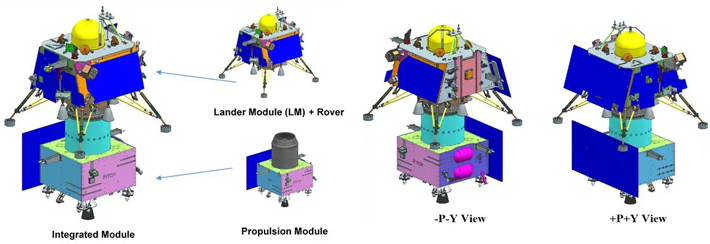
The lander has a mass of 1,752 kg, including 26 kg for the rover, and can generate 738 W using side-mounted solar panels. It has multiple sensors to ensure safe touchdown. Reaction wheels are used for attitude control, and propulsion is provided by a MMH and MON3 bipropellant system with four 800 N throttleable engines and eight 58 N throttleable engines. An X-band antenna is used for communications. The lander carries the rover in a compartment with a ramp for deployment onto the surface. The rover is a rectangular chassis mounted on a six-wheel rocker-bogie wheel drive assembly. It has navigation cameras and a solar panel that can generate 50 W. It communicates directly with the lander via Rx/Tx antennas.
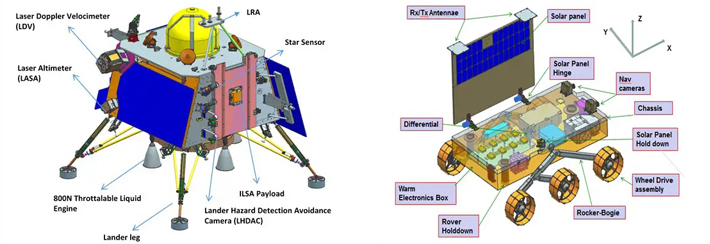
The lander will carry the Chandra’s Surface Thermophysical Experiment (ChaSTE) to measure surface thermal properties, the Instrument for Lunar Seismic Activity (ILSA) to measure seismicity around the landing site, the Radio Anatomy of Moon Bound Hypersensitive ionosphere and Atmosphere (RAMBHA) to study the gas and plasma environment, and a passive laser retroreflector array provided by NASA for lunar ranging studies.
ISRO's Chandrayaan-3 mission aims to demonstrate end-to-end landing and roving capabilities near the South pole of the Moon, conducting scientific measurements and paving the way for future lunar missions
The rover will carry two instruments to study the local surface elemental composition, an Alpha Particle X-ray Spectrometer (APXS) and Laser Induced Breakdown Spectroscope (LIBS). The Propulsion Module/Orbiter will carry one experiment called the Spectropolarimetry of HAbitable Planet Earth (SHAPE) to study Earth from lunar orbit.
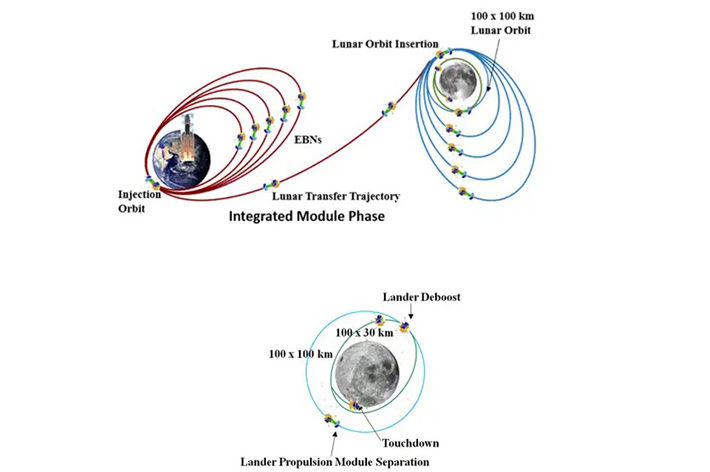
ISRO also plans to launch a Quantum Technology Satellite using a team of scientists from the Physical Research Laboratory (PRL) in collaboration with ISRO-Space Applications Centre (SAC) and several other institutions, working over the next two years to propel the advancements in quantum communication technology. The ultimate goal is to integrate this technology into ISRO's satellites, enabling closed-loop communication with minimal signal attenuation through Quantum Key Distribution (QKD). QKD relies on the principles of quantum physics rather than traditional mathematical calculations, making it an exceptionally secure method of communication. At the heart of quantum communications and cryptographic systems, QKD ensures robust data transfer with unrivalled security. It may be recalled that in March 2020, ISRO-SAC demonstrated free-space quantum communication across a distance of 300 meters.
Erisha Space plans to launch a state-of-the-art satellite contributing to remote sensing, GIS, and photogrammetry for sustainable resource management and national missions
In another space related development, Delhi-based ‘Erisha Space’ plans to launch a state-of-the-art satellite in 2024 for contributing to a sustainable future. The satellite will be equipped with advanced image processing capabilities and machine learning/artificial intelligence frameworks, enabling comprehensive solutions for remote sensing, GIS, and photogrammetry across various sectors. The aim is to provide valuable insights into earth’s resources, facilitate effective planning and monitoring of national missions, and contribute to a more sustainable future.

In addition, ‘Erisha Space’ has plans to develop a Small Satellite Launch Vehicle (SSLV) by 2025-2026, with the goal of reducing launch costs and transforming into a reusable launch vehicle. The SSLV will be capable of delivering up to 1000 kg payload to low Earth orbit, with the long-term goal of transforming into a reusable launch vehicle to reduce launch costs. The company has invited individuals and organisations to join them in their groundbreaking venture towards a more environmentally conscious and sustainable world.





